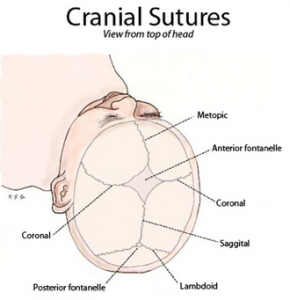The bones of the human skull are joined together by cranial sutures, that allow the natural cranial growth during the infancy.
Craniosynostosis is the premature fusion of one or more of these sutures, where the growth of the skull is restricted, resulting in compensatory mechanisms which cause irregular growth patterns and skull deformation. Growth in the skull is perpendicular to the sutures.
When a suture fuses too early, the growth perpendicular to that suture will be restricted, and the bone growth near the other sutures will be stimulated, causing an abnormal head shape.

The expanding brain is the main stimulus for the rapid growth of the skull in the first years of life. Inhibited growth potential of the skull can restrict the volume, needed by the brain. In cases in which the compensation does not effectively provide enough space for the growing brain, craniosynostosis results in increased intracranial pressure.
Craniosynostosis can occur as part of a syndrome or as an isolated defect (nonsyndromic).
There are several classifications of deformities according to the type of suture fusion:
- Scaphocephaly: in scaphocephaly the saggital suture is prematurely fused. The sagittal suture runs from the front to the back of the head. The shape of this deformity is a long narrow head, formed like a boat (Greek skaphe, “light boat or skiff”). Scaphocephaly is the most common form of craniosynostosis.
- Trigonocephaly: in trigonocephaly the metopic suture is prematurely fused. The metopic suture is situated in the medial line of the forehead. Premature fusion of this suture causes the forehead to become pointed, giving the head a triangular shape when viewed from above (Greek trigono, “triangle”). Trigonocephaly is the second most common type of craniosynostosis.
- Plagiocephaly: In plagiocephaly one of the coronal or one of lambda sutures is prematurely fused. The coronal sutures run over the top of the head, just in front of the ears and the lambda sutures are located in the posterior region of the skull. The shape of this deformity is an asymmetrical distortion (flattening of one side of the head).

Craniosynostosis can be successfully treated if the surgery is performed at the right age, preventing the raise of intracranial pressure and the possible damage of brain and optical nerve. The surgery is usually necessary during the first year of age, in average at 8 -month-old. In cases of multiple suture synostosis earlier intervention is probably needed.
There are different surgical techniques for the treatment of craniosynostosis. We perform cranial osteotomies and cranial vault remodeling to reshape and correct the cranial anatomy and also promote enough space for brain growth. We also perform cranial vault distraction, particularly in cases that need larger intracranial expansion.
The surgeries are performed at the Tallinn Children’s hospital by the teamwork of maxillofacial- and neurosurgeon. We have a complex multidisciplinary team in cooperation of Tallinn Children’s hospital, which provides a complete care of all patients with craniofacial anomalies in Estonia.
